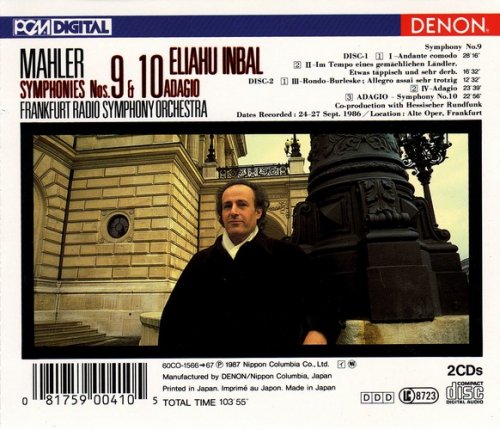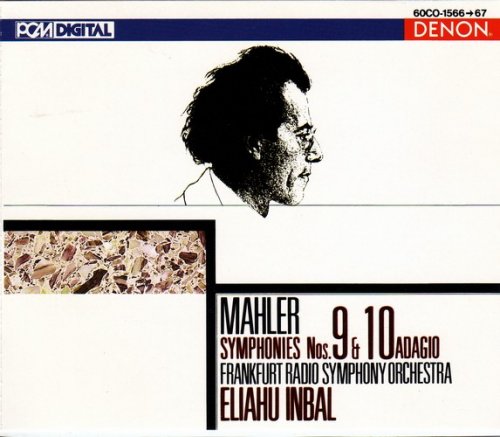
Frankfurt Radio Symphony Orchestra, Eliahu Inbal - Mahler: Symphony Nos. 9 & 10 Adagio (1987) CD-Rip
BAND/ARTIST: Frankfurt Radio Symphony Orchestra, Eliahu Inbal
- Title: Mahler: Symphony Nos. 9 & 10 Adagio
- Year Of Release: 1987
- Label: Denon
- Genre: Classical
- Quality: FLAC (image+.cue,log,scans)
- Total Time: 103:55
- Total Size: 551 Mb
- WebSite: Album Preview
Tracklist:
Symphony No. 9 (Gustav Mahler)
01. I. Andante comodo - 00:28:16
02. II. Im Tempo eines gemächlichen Ländler. Etwas täppisch und sehr derb - 00:16:32
03. III. Rondo-Burleske; Allegro assai, sehr trotzig - 00:12:32
04. IV. Adagio - 00:23:39
Adagio from Symphony No. 10 (Gustav Mahler)
05. Adagio - 00:22:56
Performers:
Frankfurt Radio Symphony Orchestra
Eliahu Inbal - conductor

Symphony No. 9 (Gustav Mahler)
01. I. Andante comodo - 00:28:16
02. II. Im Tempo eines gemächlichen Ländler. Etwas täppisch und sehr derb - 00:16:32
03. III. Rondo-Burleske; Allegro assai, sehr trotzig - 00:12:32
04. IV. Adagio - 00:23:39
Adagio from Symphony No. 10 (Gustav Mahler)
05. Adagio - 00:22:56
Performers:
Frankfurt Radio Symphony Orchestra
Eliahu Inbal - conductor
Inbal and the Frankfurt Radio Symphony Orchestra are nearing completion of their Mahler cycle, which on the whole is highly distinguished. This two-disc set gives us the climactic Ninth Symphony, arguably the greatest work of its kind composed in this century, and the opening Adagio of the Tenth in the Erwin Ratz 1964 edition. Presumably Inbal rejects the Deryck Cooke performing version, which is an immense pity because judging from his incandescent interpretation of this first movement, he would have something special to tell us about it.
A particularly welcome feature of the Inbal cycle where recording is concerned is the superb balance obtained by the Denon engineers. For the most part only two microphones are used and we are told that very long 'takes' were made certainly that is how the performance sounds, and therefore one gets the spontaneous effect of a live performance made in a studio (the Frankfurt Alte Oper). Compared with the DG recording for Karajan (which is of a 1982 Berlin Festival performance and was Gramophone's Record of the Year in 1984) and the Philips for Haitink, the Denon sound, when played at the same level, is more recessed, less immediate, but a twitch on the volume-control alters that.
The very first notes of the double-basses and the rasp of the muted horns on both DG and Philips are much more closely recorded than by Denon, but I feel that overall the Denon method achieves the more natural result. All three of these recordings are outstanding for clarity of texture—for an example of the standard prevailing on this new Denon issue, listen to the violas in the nine bars preceding fig. 5 in the first movement.
The Frankfurt orchestra are on superb form although one still has to say that the Karajan recording caught the Berlin Philharmonic on one of those days when they play with a superhuman refinement of tone and texture. Nevertheless, the Frankfurt strings have a richness and fluency which are always a pleasure to hear and the horn section, its principal especially, is beyond praise and on this form can stand comparison with any. The solo violin's playing at the end of the first movement is also first class.
What of Inbal's interpretation? I like it very much. He is very strong on the structure of the first movement, which sounds more than ever like the meeting and mingling of the old and the new in music, the bridge to the harmonic developments which altered the face of music between 1910 and 1930. His tempos are almost identical with Karajan's except in the final Adagio where he is three minutes quicker and a minute faster even than Haitink. Yet there is no loss of emotional force. The music of this sublime movement is treated by Inbal as a noble elegy, a welcome and refreshing change for this reviewer from the embarrassingly sentimental, indeed almost slobbering, agonizing of Bernstein's recent Amsterdam recording (DG 419 208-1GH2; (D 419 208-2GH2, 12/86). Inbal is impressive, too, in the Rondo Burleske, where the ironic intent, never an easy thing to convey in music, comes over forcefully. His tempo for the second movement may seem a fraction too deliberate, but one is soon lost in admiration for the horn-playing.
Like the DG and Philips issues, the Denon takes two CDs, with the Adagio of No. 10 as a generous (and magnificently played) fill-up. Haitink/Philips offer Kindertotenlieder sung by Hermann Prey as a filler and Karajan/DG nothing. All three recordings are copiously indexed, the DG and Philips in bands, the Denon in a band for each movement with indexing within each movement. Choice between these recordings is really invidious. The Karajan, of course, is a remarkable testament but Inbal has insights, too, which Mahlerians will want to experience.'
A particularly welcome feature of the Inbal cycle where recording is concerned is the superb balance obtained by the Denon engineers. For the most part only two microphones are used and we are told that very long 'takes' were made certainly that is how the performance sounds, and therefore one gets the spontaneous effect of a live performance made in a studio (the Frankfurt Alte Oper). Compared with the DG recording for Karajan (which is of a 1982 Berlin Festival performance and was Gramophone's Record of the Year in 1984) and the Philips for Haitink, the Denon sound, when played at the same level, is more recessed, less immediate, but a twitch on the volume-control alters that.
The very first notes of the double-basses and the rasp of the muted horns on both DG and Philips are much more closely recorded than by Denon, but I feel that overall the Denon method achieves the more natural result. All three of these recordings are outstanding for clarity of texture—for an example of the standard prevailing on this new Denon issue, listen to the violas in the nine bars preceding fig. 5 in the first movement.
The Frankfurt orchestra are on superb form although one still has to say that the Karajan recording caught the Berlin Philharmonic on one of those days when they play with a superhuman refinement of tone and texture. Nevertheless, the Frankfurt strings have a richness and fluency which are always a pleasure to hear and the horn section, its principal especially, is beyond praise and on this form can stand comparison with any. The solo violin's playing at the end of the first movement is also first class.
What of Inbal's interpretation? I like it very much. He is very strong on the structure of the first movement, which sounds more than ever like the meeting and mingling of the old and the new in music, the bridge to the harmonic developments which altered the face of music between 1910 and 1930. His tempos are almost identical with Karajan's except in the final Adagio where he is three minutes quicker and a minute faster even than Haitink. Yet there is no loss of emotional force. The music of this sublime movement is treated by Inbal as a noble elegy, a welcome and refreshing change for this reviewer from the embarrassingly sentimental, indeed almost slobbering, agonizing of Bernstein's recent Amsterdam recording (DG 419 208-1GH2; (D 419 208-2GH2, 12/86). Inbal is impressive, too, in the Rondo Burleske, where the ironic intent, never an easy thing to convey in music, comes over forcefully. His tempo for the second movement may seem a fraction too deliberate, but one is soon lost in admiration for the horn-playing.
Like the DG and Philips issues, the Denon takes two CDs, with the Adagio of No. 10 as a generous (and magnificently played) fill-up. Haitink/Philips offer Kindertotenlieder sung by Hermann Prey as a filler and Karajan/DG nothing. All three recordings are copiously indexed, the DG and Philips in bands, the Denon in a band for each movement with indexing within each movement. Choice between these recordings is really invidious. The Karajan, of course, is a remarkable testament but Inbal has insights, too, which Mahlerians will want to experience.'

Classical | FLAC / APE | CD-Rip
As a ISRA.CLOUD's PREMIUM member you will have the following benefits:
- Unlimited high speed downloads
- Download directly without waiting time
- Unlimited parallel downloads
- Support for download accelerators
- No advertising
- Resume broken downloads


